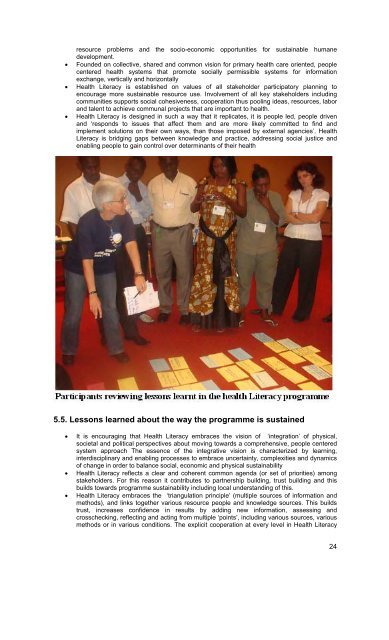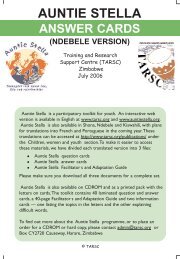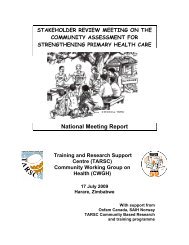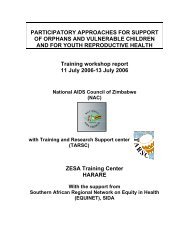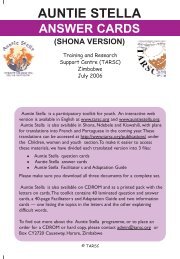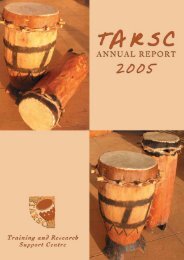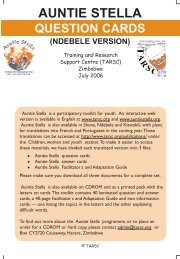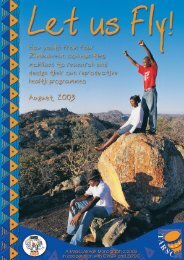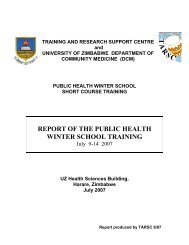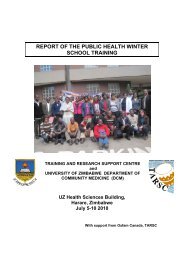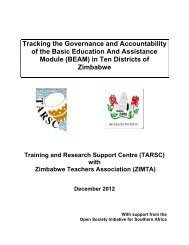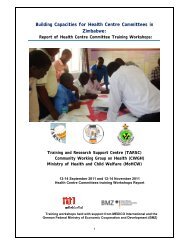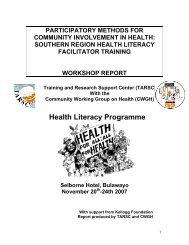HLregional meeting09.pdf - Training and Research Support Centre
HLregional meeting09.pdf - Training and Research Support Centre
HLregional meeting09.pdf - Training and Research Support Centre
Create successful ePaper yourself
Turn your PDF publications into a flip-book with our unique Google optimized e-Paper software.
esource problems <strong>and</strong> the socio-economic opportunities for sustainable humane<br />
development.<br />
• Founded on collective, shared <strong>and</strong> common vision for primary health care oriented, people<br />
centered health systems that promote socially permissible systems for information<br />
exchange, vertically <strong>and</strong> horizontally<br />
• Health Literacy is established on values of all stakeholder participatory planning to<br />
encourage more sustainable resource use. Involvement of all key stakeholders including<br />
communities supports social cohesiveness, cooperation thus pooling ideas, resources, labor<br />
<strong>and</strong> talent to achieve communal projects that are important to health.<br />
• Health Literacy is designed in such a way that it replicates, it is people led, people driven<br />
<strong>and</strong> ‘responds to issues that affect them <strong>and</strong> are more likely committed to find <strong>and</strong><br />
implement solutions on their own ways, than those imposed by external agencies’. Health<br />
Literacy is bridging gaps between knowledge <strong>and</strong> practice, addressing social justice <strong>and</strong><br />
enabling people to gain control over determinants of their health<br />
5.5. Lessons learned about the way the programme is sustained<br />
• It is encouraging that Health Literacy embraces the vision of ‘integration’ of physical,<br />
societal <strong>and</strong> political perspectives about moving towards a comprehensive, people centered<br />
system approach The essence of the integrative vision is characterized by learning,<br />
interdisciplinary <strong>and</strong> enabling processes to embrace uncertainty, complexities <strong>and</strong> dynamics<br />
of change in order to balance social, economic <strong>and</strong> physical sustainability<br />
• Health Literacy reflects a clear <strong>and</strong> coherent common agenda (or set of priorities) among<br />
stakeholders. For this reason it contributes to partnership building, trust building <strong>and</strong> this<br />
builds towards programme sustainability including local underst<strong>and</strong>ing of this.<br />
• Health Literacy embraces the ‘triangulation principle’ (multiple sources of information <strong>and</strong><br />
methods), <strong>and</strong> links together various resource people <strong>and</strong> knowledge sources. This builds<br />
trust, increases confidence in results by adding new information, assessing <strong>and</strong><br />
crosschecking, reflecting <strong>and</strong> acting from multiple ‘points’, including various sources, various<br />
methods or in various conditions. The explicit cooperation at every level in Health Literacy<br />
24


